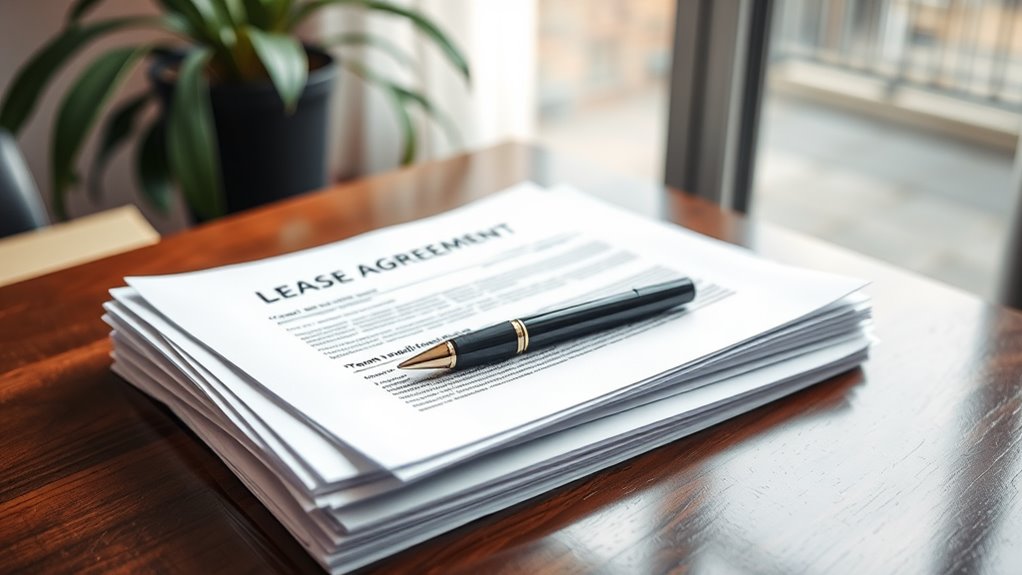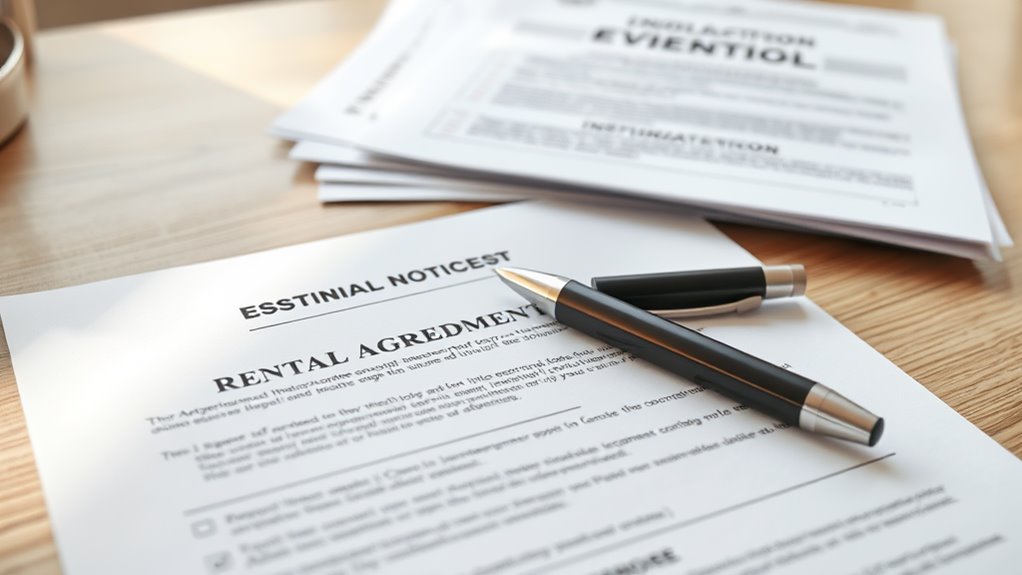Essential landlord forms streamline tenant management and guarantee legal compliance. You’ll need a rental application to collect personal and financial details. Tenant screening documents include credit and eviction history checks. A lease or rental agreement defines terms like rent and responsibilities. Pet agreements specify rules and liabilities. Welcome letters set expectations, while move-in and move-out checklists document property condition. Lease renewal paperwork formalizes extended tenancies. These forms protect your investment and maintain clear communication. Exploring these further guarantees thorough understanding and smooth operations.
Key Takeaways
- Rental applications capture essential tenant information and authorize background checks for thorough screening.
- Lease agreements define rent, duration, and responsibilities to protect landlord and tenant interests.
- Move-in checklists document property condition to prevent disputes over damages at lease end.
- Welcome letters set expectations and provide essential contact and utility setup information for new tenants.
- Move-out letters outline tenant obligations and security deposit return procedures for smooth transitions.
Rental Application
When you’re screening prospective tenants, the rental application serves as the foundational document for gathering critical personal and financial information. It captures essential details such as contact information, employment history, and references, enabling you to assess their reliability. You must guarantee applicants authorize background checks, including a credit report and eviction history, to evaluate their suitability. Compliance with the Fair Housing Act is mandatory, so you must treat all applicants equally and avoid discriminatory practices using these landlord forms. Legal requirements dictate that you retain all rental applications, including those of rejected applicants, for a specified period, typically at least two years. Customizable templates are available from local real estate associations or online resources, allowing you to tailor the rental application to your specific needs while adhering to tenant screening regulations. This process guarantees thorough and lawful evaluation of prospective tenants. Utilizing comprehensive checks through platforms like RentPrep can further enhance the accuracy of your tenant evaluations.
Tenant Screening Documents
You’ll verify criminal records and identity through a background check to assess risk levels. Analyze credit reports to evaluate financial responsibility and payment history. Review eviction history to identify prior tenancy issues and potential red flags. Understanding financing contract terms can also provide insight into a tenant’s financial obligations and stability.
Background Check Essentials
Tenant screening documents form the cornerstone of a thorough background check process, enabling landlords to evaluate prospective tenants effectively. These documents, including credit reports and eviction history, guarantee extensive tenant screening. You’ll assess rental history, verify employment, and review criminal records to make informed decisions. Tools like TransUnion SmartMove streamline the tenant screening process by providing detailed reports, including credit scores and eviction history. Compliance with fair housing laws is critical; you must apply universal rental criteria uniformly to avoid discrimination claims. Documenting every step of the tenant screening process not only guarantees compliance but also strengthens legal protection. Retain all background checks and related records to safeguard against potential audits or disputes. Proper tenant screening minimizes risks and supports responsible property management practices. Integrating tenant management systems can further enhance efficiency and streamline the entire process.
Credit Report Analysis
Although credit reports are just one element of tenant screening, they’re critical for evaluating an applicant’s financial reliability and payment behavior. Landlords use credit reports to assess financial stability, reviewing credit history for patterns like timely payments, outstanding debts, or bankruptcies. A credit score above 740 is typically excellent, while 670–739 indicates good standing, influencing approval decisions. To comply with the Fair Housing Act, you must apply consistent evaluation criteria to all applicants, avoiding discriminatory practices. Document your screening process clearly to defend against discrimination claims and guarantee transparency. Retain credit reports in application records for future reference or disputes. Partner with reliable screening services like TransUnion SmartMove® to obtain thorough reports. This approach safeguards your rental business while maintaining legal and ethical standards in tenant screening.
Eviction History Review
When reviewing tenant screening documents, eviction history offers critical insights into an applicant’s past rental behavior and potential risks. Landlords use screening services to access eviction records, which detail past evictions, reasons, and outcomes. Documenting this information guarantees compliance with fair housing laws and helps establish universal rental criteria. Retaining eviction history as part of the tenant application process protects against discrimination claims and demonstrates due diligence. A history of evictions can signal future risks, so thorough review is essential. States like Texas and Florida have streamlined eviction processes that help landlords act quickly against non-compliant tenants.
| Criteria | Purpose | Benefit |
|---|---|---|
| Eviction Records | Assess rental behavior | Identify potential risks |
| Universal Criteria | Guarantee fair evaluation | Maintain compliance |
| Documentation | Retain screening evidence | Protect against claims |
Lease or Rental Agreement

A lease or rental agreement defines key terms such as rent, lease duration, and property responsibilities, ensuring clarity for both parties. It outlines legal obligations, including maintenance duties, pet policies, and lead-based paint disclosures for pre-1978 properties. You must retain signed copies of the agreement to document terms and resolve disputes effectively.
Key Terms Overview
Understanding the key terms of a lease or rental agreement secures clarity and legal compliance for both landlord and tenant. A lease agreement specifies the rental property address, lease duration, and payment terms, including rent amount, due dates, and late fees. It also outlines the security deposit details, such as the amount, permissible uses, and conditions for return. The pet policy, if applicable, must be clearly stated to avoid disputes. Proper tenant screening guarantees a reliable rental application process, while lease renewal terms should be documented accurately. Both parties must retain important documents, including the lease agreement and any amendments, as these serve as essential documentation throughout the duration of the tenancy, promoting transparency and legal protection. Landlord-tenant laws govern rental agreements and are crucial for legal disputes resolution.
Legal Obligations Outlined
Since a lease or rental agreement is legally binding, it’s crucial to clearly outline the obligations of both the landlord and tenant. The lease agreement specifies the rights and responsibilities of each party, including rent payment terms, late fees, and property maintenance duties. It must also detail eviction processes to address non-compliance. As a legal contract, the agreement should include required disclosures, such as lead-based paint hazards in properties built before 1978, to guarantee regulatory compliance. Both parties must retain copies of the lease documentation to resolve disputes effectively. Verify the rental application aligns with the lease terms to prevent misunderstandings. Regularly update the agreement to reflect current laws, safeguarding both the landlord and tenant from legal complications. Utilizing property management software can streamline the creation, storage, and execution of lease agreements, ensuring a more efficient process.
Pet Policy Agreement
When renting a property that permits pets, a Pet Policy Agreement is essential to establish clear expectations and responsibilities for both landlords and tenants. This agreement guarantees transparency by detailing specific terms, such as pet deposits and pet rent, which cover potential damages and additional wear and tear. You’ll also define the types of pets allowed, including breed or size restrictions, to align with your property protection goals.
The agreement should address:
- Pet Behavior: Specify expectations for noise restrictions and proper training to minimize disturbances.
- Damage Liability: Clearly state the tenant’s responsibility for any pet-related property damage.
- Compliance: Require tenant understanding and acknowledgment of all pet-related rules.
Welcome Letter

A Welcome Letter formally introduces tenants to the property and sets clear expectations for their tenancy. It outlines essential guidelines, responsibilities, and rules to guarantee compliance with lease terms and property standards. You’ll provide tenants with contact information for maintenance, emergencies, and general inquiries to facilitate effective communication. Include instructions for setting up utilities, such as electricity, water, and internet, to guarantee a seamless move-in process. Clarify specific rules related to garbage collection, parking, or shared spaces to prevent misunderstandings. Emphasize the importance of obtaining renters insurance to protect personal belongings. By detailing these aspects, the welcome letter fosters transparency and trust and helps tenants understand their obligations. It also serves as a reference document for addressing questions or concerns throughout the tenancy, promoting a positive landlord-tenant relationship. Ascertain the letter complies with local laws to maintain legal adherence and reinforce professionalism.
Move-In Checklist
To guarantee clarity and accountability at the start of a tenancy, a move-in checklist serves as a critical document. It captures the property condition at move-in, affirming clarity and transparency for both landlord and tenant. The checklist includes a room-by-room breakdown, documenting walls, floors, windows, and existing wear and tear. This step-by-step assessment establishes tenant accountability by requiring their acknowledgment of the property’s state. A signed move-in checklist helps resolve disputes regarding damages at the end of the lease, as it provides clear evidence for security deposit assessments. Before move-in, you should review the checklist with tenants to affirm mutual understanding.
- Inspect floors for scratches, stains, or damage.
- Check walls for holes, cracks, or paint discoloration.
- Confirm fixtures, such as lights and faucets, are functional.
This process safeguards both parties, minimizing ambiguity during move-out inspections.
Lease Renewal Paperwork

Lease renewal paperwork formalizes the extension of a tenancy agreement, guaranteeing both parties agree to updated terms before the current lease ends. You should initiate the renewal process at least 90 days prior to lease termination to provide ample time for discussion and preparation. These landlord documents protect rental income and allow you to adjust rental agreements based on market conditions or policy changes. Include details like tenant responsibility, rent adjustments, and notice to enter clauses in the renewal paperwork. Use a structured rental application template to guarantee thorough coverage of all terms. Properly documented lease renewals guarantee legal compliance and help resolve potential disputes. Maintain organized records of all landlord documents, including signed renewal agreements, to safeguard your interests and maintain transparency with tenants throughout the renewal process.
Move-Out Letter
When the lease termination date approaches, you must issue a Move-Out Letter to tenants, guaranteeing they understand their obligations and the steps required for vacating the property. The Move-Out Letter should clearly outline the cleaning requirements, the process for the final inspection, and the procedures for returning the security deposit. This document serves as a critical tool for communication and record-keeping, helping to avoid disputes over the tenant’s departure and property condition.
- Cleaning Requirements: Specify the level of cleanliness expected, such as removing personal items, deep cleaning carpets, and wiping surfaces.
- Final Inspection: Set a date and time for the inspection, and inform tenants they must be present to review any potential deductions.
- Security Deposit: Explain the timeline and conditions for returning the deposit, including deductions for damages or unpaid rent.
Maintaining clear communication through a Move-Out Letter guarantees a smooth changeover and protects both parties from misunderstandings.
Conclusion
Ensuring you’ve got the right forms in your landlord arsenal is like having a quill in a digital age—timeless yet essential. Use a rental application to vet tenants, screen with precision, and cement agreements with a clear lease. Establish pet policies, welcome tenants, and document move-ins meticulously. Renew leases promptly and issue move-out notices lawfully. These forms shield your interests and maintain professionalism, safeguarding your property and fostering smooth landlord-tenant relationships.




